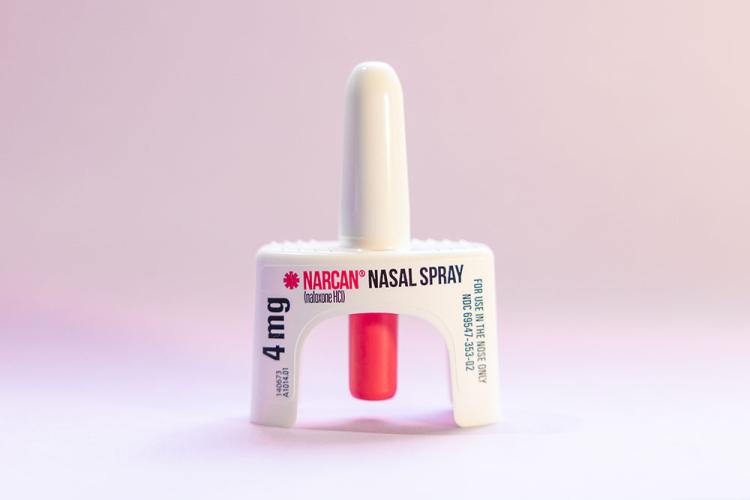
Ohio University and state of Ohio partner in fight against opioid overdoses

Across the United States, accidental fentanyl ingestion is taking the lives of thousands of young adults. Ohio University is leading an initiative with the state of Ohio to help prevent such deaths and make naloxone – a potentially life-saving antidote to fentanyl overdose – accessible across its Athens campus.
The University is installing emergency naloxone access cabinets provided by Governor Mike DeWine's Recovery Ohio, the Ohio Department of Higher Education, and the Ohio Department of Health.
“Oftentimes people ingest fentanyl without knowing they are ingesting fentanyl,” said Rebecca Miller, senior director of community relations in the College of Health Sciences and Professions. “And that's often what causes overdose,” she said, alluding to the unknowing ingestion of an opioid substance at much higher levels than a person can tolerate. “Fentanyl has been found in pretty much every drug that there is at this point, like Adderall, cocaine, sometimes even marijuana.”
Dean of Students Kathy Fahl said naloxone cabinets have been installed in five high-traffic places on the Athens campus: Alden Library, Baker Center, Ping Recreation Center, The District on West Green (Boyd Hall), and Nelson dining hall
The cabinets are stocked with 4-milligram intranasal spray doses of naloxone, under the brand name Narcan, and include instructions for administering it to someone experiencing an opioid overdose. “It's very simple to use. If someone is not overdosing, but they are administered Narcan, it's not going to harm them,” Fahl said.
Fahl said the University has also joined forces with the Ohio Opioid Education Alliance, which will allow for additional student and staff training and the use of their educational campaign materials.
Signs of an opioid overdose include unconsciousness, slow or shallow breathing, vomiting, lack of speech, faint heartbeat, pale skin, small pupils and pale or purple lips and fingernails. The National Institute on Drug Abuse’s website states the first most important step for anyone administering Narcan is to call 911, and instructs responders to keep watch over the person given naloxone until medical help arrives. Ohio’s Good Samaritan Law provides legal immunity for someone calling 911 for assistance, regardless of whether the caller has also used substances. Steps for responding to an opioid overdose can be found in the Substance Abuse and Mental Health Administration’s (SAMHSA) Opioid Overdose Prevention Toolkit.
Miller wants to educate the community about opioid overdoses that don’t converge with common assumptions about drug use, such as substance abuse or partying. “We need to recognize that [sometimes] students don’t have a prescription for study enhancement drugs, and are sourcing them from places other than pharmacies,” she said.
Ann Brandon, associate director of prevention and education in the office of Student Affairs, explained that the accessibility of the cabinets is meant to provide rescue assistance for more than on-the-spot overdoses. “[Students are] probably taking naloxone back to where their housing is, rather than thinking of this as an immediate crisis,” Brandon said. “This is a harm reduction strategy that's been used for many, many years.”
Brandon said keeping the on-campus naloxone cabinets stocked is critical, as is tracking data of their use. “What we're finding out is people are utilizing them more than for just an immediate crisis or emergencies,” she said, and are carrying naloxone with them as recommended by the Ohio Department of Health’s Project DAWN.
In 2021, health policy research organization KFF listed the state of Ohio as the fourth-highest state in the number of opioid-related deaths, behind California, Florida, and New York, and sixth in opioid-related deaths per 100,000 people. Reducing barriers to naloxone access is one of the first goals of this collective, ongoing project, Miller said. “I really see that as the next educational opportunity, helping people understand the need for everyone to have access to naloxone, and even to keep it on hand in case of an emergency.”
Fahl said the naloxone distribution initiative is a cross-campus effort, noting that in addition to campus sites hosting the cabinets and staff and student training, the Heritage College of Osteopathic Medicine’s Heritage Community Clinic is helping to resupply the cabinets. Fahl added that the cabinets include a QR code that members of the community can use to alert the clinic that a restock is needed.
While the naloxone cabinets represent a first-line effort to stem the tide of opioid-related deaths in the state, Brandon explained, “The boxes are just a first step towards reducing harm.”
She said the University will continue in its joint efforts to educate the public and dispel myths around drug misuse disorders.
Miller said the initiative to increase access to naloxone on the Athens campus started in fall 2022, given increases in the number of overdoses at college campuses around the nation. “[It’s been a] great collaboration with the Athens City County Health Department to train OHIO staff,” she said, noting that OHIO Counseling and Psychological Services Assistant Director for Outreach and Consultation Stephanie Maccombs-Hunter, Ph.D., LPCC-S, LICDC, CRC orchestrated the development and direction of the naloxone training.
“This is how collaborative harm reduction should be done,” Brandon added, noting the important partnerships not only at the state level and within the University but throughout the Athens community, including the Athens Police Department. “There’s a great energy” to this collaboration, she said.
Besides the on-campus distribution points, naloxone is available at many pharmacies without a prescription, including Kroger, Shrivers, and CVS. For additional information about naloxone, contact the Athens City County Health Department at (740) 447-5900 or visit the NaloxoneOhio website to order a naloxone kit through the mail.
